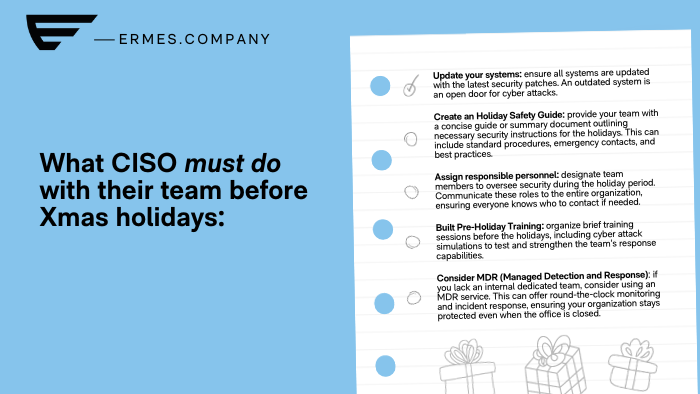As the holiday season approaches, cybersecurity becomes even more critical for businesses. During this time, Chief Information Security Officers (CISOs) face unique challenges, ensuring that protective measures are not only effective but also properly implemented. Holidays often bring reduced staff and increased online activities, creating fertile ground for cyberattacks. Therefore, it’s crucial for CISOs and their teams to take proactive steps to strengthen corporate defenses.
This article explores crucial actions CISOs must take before the holiday season, including system updates, creating security guides, assigning responsible staff, pre-holiday training, and considering Managed Detection and Response (MDR) services. These actions are essential to ensure organizations remain protected during a potentially vulnerable period.

Task List Ciso before Christmas
Patch Installation: System Updates
Security updates are vital to shield corporate networks from known vulnerabilities. Security patches released by software providers fix bugs and vulnerabilities that attackers can exploit to infiltrate systems. An outdated system is like an open door for cybercriminals. During the holidays, when IT resources may be limited, ensuring all systems are updated is even more critical.
Steps to Ensure All Systems Are Updated:
- Conduct a comprehensive inventory of all devices and software in use.
- Verify the availability of security updates for each element and plan systematic patch installations.
- Establish a regular update policy and automate the process where possible to reduce the risk of oversights or delays.
- Test updates in a controlled environment before deploying them on a large scale to avoid service disruptions or compatibility issues.
Consequences of Unpatched Systems:
Failure to install security updates can lead to devastating consequences. Cyberattacks exploiting known vulnerabilities can result in data loss, business operation disruptions, reputation damage, and expensive recovery processes. Regularly updated systems are crucial, especially during the holidays when monitoring activities may be reduced.
Creating a Holiday Security Guide
The holiday season is a time of increased activity, not only for families and businesses but also for cybercriminals. It’s essential for CISOs and their teams to prepare a holiday security guide to ensure everyone is informed and protected.
Key Elements to Include in the Guide:
- Software Updates: Ensure all devices are updated with the latest software versions, including phones, computers, tablets, and internet-connected appliances and toys.
- Strong Passwords and Password Management: Encourage the use of complex and unique passwords for each account and the use of a password manager.
- Privacy and Security Settings: Check and configure device privacy and security settings to limit the sharing of personal information.
- Two-Factor Authentication: Promote the use of two-factor authentication where available.
- Phishing Awareness: Educate staff on phishing scam warning signs and how to avoid them.
- Online Transaction Security: Advise using credit cards rather than debit cards for online purchases and verifying the security of websites before entering sensitive information.
- Reviewing Bank Statements: Encourage regular bank statement checks to detect any fraudulent charges.
Tips for Effective Guide Distribution:
- Digital Communication: Send the guide via email or through the company’s internal communication system.
- Training Sessions: Organize short training sessions to discuss key guide points.
- Accessibility: Ensure easy access to the guide, such as through the company intranet.
- Regular Updates: Update the guide with new information and tips, especially before the holidays.
Examples of Best Holiday Security Practices:
- Avoiding Public Wi-Fi for Sensitive Transactions: Refrain from using insecure public Wi-Fi for banking or shopping operations.
- Secure Online Shopping: Use only reputable and secure websites for online purchases, and be cautious of deals that seem too good to be true.
- Device Protection: Ensure all devices are protected with updated antivirus and antimalware software.
According to Ermes, creating a holiday security guide is a fundamental step to ensure staff is informed and protected from potential threats. With the right preparation and awareness, it’s possible to enjoy the holidays safely and securely.
Pre-Holiday Training and Cyber Attack Simulations
The holiday season is a time when cybersecurity becomes even more crucial. For CISOs, it’s essential to leverage this time to strengthen organizational defenses. One fundamental step is organizing targeted training sessions focused on realistic and current scenarios.
These training sessions should include updates on the latest cyber threats, with a particular emphasis on common attacks during the holidays, such as phishing and ransomware. Training should be interactive and engaging, using techniques like gamification to increase interest and participation. Every team member should understand not only standard procedures but also specific actions to take in the event of an attack. This includes knowledge of immediate response protocols and the ability to identify and report intrusion attempts.
Another crucial aspect is the implementation of cyber attack simulations. These practical exercises allow the team to experience firsthand attack scenarios, testing their readiness and response capabilities. Simulations should be as realistic as possible, covering a variety of attack techniques, from simple to sophisticated. The goal is to identify strengths and areas for improvement in the organization’s incident response plan.
After each training session or simulation, it’s crucial to conduct a thorough debriefing. This should include a discussion of actions taken, the effectiveness of the response, and strategies for improvement. It’s also the time to update incident response plans and review security policies, ensuring they align with emerging threats and industry best practices.
Through comprehensive training and realistic simulations, CISOs can ensure their team is well-prepared to face any security challenge that may arise during the holidays, ensuring the organization’s protection in a period of heightened risk.


Follow us on: